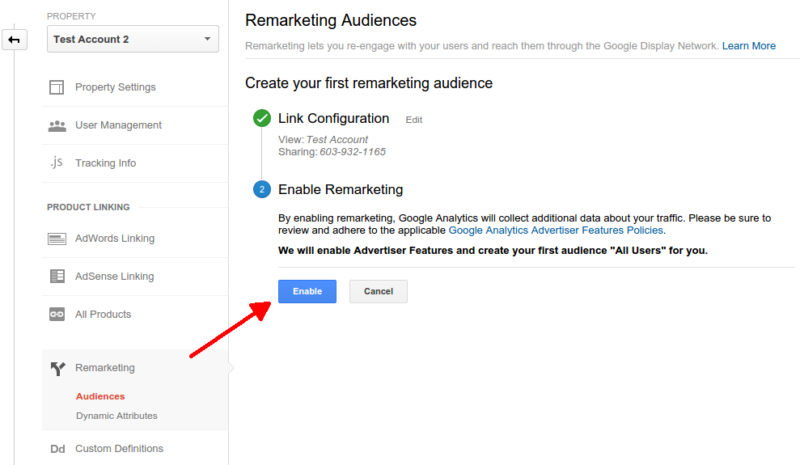Using Remarketing in Google Analytics: A Comprehensive Overview
Harnessing remarketing in Google Analytics offers services a strategic edge in reaching out to possible customers. This guide will shed light on the necessary actions included in utilizing the full capacity of remarketing in Google Analytics, leading to improved advertising end results.
Recognizing Remarketing in Google Analytics
Remarketing in Google Analytics permits organizations to purposefully target individuals that have formerly interacted with their web site or mobile app. By leveraging data from Google Analytics, companies can create personalized remarketing lists based on individual actions, such as web pages gone to, activities taken, or details goals attained. This effective tool makes it possible for organizations to re-engage with customers who have revealed interest in their solutions or items, ultimately boosting the probability of conversion.
Understanding the different types of remarketing approaches is crucial for an effective project - What Is “Remarketing” In Google Analytics?. Google Analytics supplies numerous choices, including typical remarketing, vibrant remarketing, and remarketing checklists for search ads (RLSA) Each type serves a distinct objective and can be customized to fulfill certain advertising goals
Moreover, evaluating the efficiency of remarketing campaigns is necessary for enhancing results. Google Analytics supplies important understandings right into the performance of different remarketing methods, permitting services to make data-driven decisions and refine their targeting approach. By constantly checking and readjusting remarketing efforts based on analytics data, organizations can make the most of ROI and drive success in their advertising initiatives.
Establishing Remarketing Campaigns

After establishing audience lists, the following action is to link Google Analytics with Google Advertisements. By connecting these 2 platforms, businesses can effortlessly transfer target market checklists from Google Analytics to Google Advertisements for remarketing purposes. This integration enables even more exact targeting and much better project efficiency.
Once the accounts are linked, organizations can develop remarketing projects in Google Ads utilizing the audience lists formerly defined in Google Analytics. These projects can be tailored with particular ad creatives, messaging, and bidding techniques to effectively re-engage with previous visitors and drive conversions. By following these actions, organizations can take advantage of the power of remarketing to boost their marketing efforts and enhance ROI.
Using Target Market Segmentation Approaches

Predefined sections in Google Analytics enable you to swiftly evaluate usual target market categories fresh users, returning individuals, or users who completed a specific goal on your website. Customized segments, on the various other hand, allow you to produce unique sections based upon particular standards that are very important to your company purposes. Dynamic remarketing listings automatically change based upon customer actions, revealing personalized ads to users that have engaged with your site in particular methods.
Analyzing Remarketing Efficiency Metrics
Upon examining the efficiency of remarketing campaigns in Google Analytics, the analysis of key performance metrics provides valuable understandings right into target market involvement and conversion prices. By delving into metrics such as click-through rates (CTR), conversion prices, expense per purchase (CPA), and return on ad spend (ROAS), marketing experts can gauge the success of their remarketing initiatives. CTR suggests the percentage of customers who clicked the ad after seeing look at this now it, mirroring the ad's significance and appeal. Conversion rates measure the percentage of individuals who finished a preferred activity, such as purchasing, after clicking on the advertisement. CPA reveals the ordinary expense sustained for each conversion, helping evaluate project earnings. ROAS, on the other hand, measures the earnings generated for every dollar invested on advertising and marketing. Assessing these metrics makes it possible for marketing professionals to enhance campaigns, fine-tune audience targeting, and assign budgets effectively to enhance total remarketing efficiency.
Maximizing Remarketing Strategies
When refining remarketing strategies in Google Analytics, concentrating on audience segmentation is extremely important for achieving project success. By dividing your target market into particular segments based on their habits, demographics, or interests, you can tailor your ads a lot more successfully per group. This targeted strategy increases the likelihood of involving individuals that have actually currently article source revealed interest in your service or products, leading to greater conversion rates.
An additional crucial element of enhancing remarketing techniques is continually testing and refining your projects (What Is “Remarketing” In Google Analytics?). A/B testing various advertisement creatives, messaging, or offers can help you recognize what resonates ideal with your target market and drives the most conversions. By evaluating the efficiency of these examinations in Google Analytics, you can make data-driven decisions to enhance your remarketing efforts other further
Additionally, leveraging dynamic remarketing can significantly boost your campaign results. This feature permits you to show customized advertisements to customers based on their previous interactions with your website, showcasing solutions or products they have actually previously seen. By delivering customized web content to users based upon their actions and interests, dynamic remarketing can help boost interaction and drive conversions.
Verdict
In conclusion, using remarketing in Google Analytics is a strategic method to target individuals who have actually previously engaged with a website. By creating tailored target market lists and utilizing audience segmentation methods, businesses can enhance remarketing advocate enhanced conversion rates. Evaluating efficiency metrics and constantly enhancing methods are critical for taking full advantage of the efficiency of remarketing initiatives.
Google Analytics uses numerous options, including basic remarketing, dynamic remarketing, and remarketing listings for search advertisements (RLSA)After establishing up target market lists, the next action is to link Google Analytics with Google Ads. By linking these two systems, services can effortlessly move target market lists from Google Analytics to Google Advertisements for remarketing functions.When the accounts are connected, businesses can develop remarketing campaigns in Google Advertisements utilizing the audience notes previously specified in Google Analytics.When refining remarketing methods in Google Analytics, concentrating on target market segmentation is paramount for accomplishing campaign success.